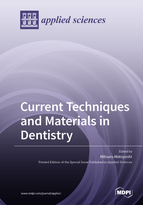Current Techniques and Materials in Dentistry
A special issue of Applied Sciences (ISSN 2076-3417). This special issue belongs to the section "Materials Science and Engineering".
Deadline for manuscript submissions: closed (31 January 2022) | Viewed by 38667
Special Issue Editor
Special Issue Information
Dear Colleagues,
The journal Applied Sciences is pleased to announce that we have launched a Special Issue entitled “Current Techniques and Materials in Dentistry”. I am serving as Guest Editor for this issue. Many innovative techniques and materials have been developed in the fields of dentistry, such as operative dentistry, endodontics, periodontics, prosthetics, orthodontics, oral surgery and so on. This Special Issue will provide a review of the recent progress in the development of treatment techniques and materials in the dentistry. Given the depth of your expertise in this field, I would like to cordially invite you to contribute an article to the Special Issue. Research articles including pure scientific research, applied research and clinical research, as well as review articles, are preferred.
We would highly appreciate it if you can also forward this message to your colleagues. We look forward to hearing from you.
Prof. Mitsuru Motoyoshi
Guest Editor
Manuscript Submission Information
Manuscripts should be submitted online at www.mdpi.com by registering and logging in to this website. Once you are registered, click here to go to the submission form. Manuscripts can be submitted until the deadline. All submissions that pass pre-check are peer-reviewed. Accepted papers will be published continuously in the journal (as soon as accepted) and will be listed together on the special issue website. Research articles, review articles as well as short communications are invited. For planned papers, a title and short abstract (about 100 words) can be sent to the Editorial Office for announcement on this website.
Submitted manuscripts should not have been published previously, nor be under consideration for publication elsewhere (except conference proceedings papers). All manuscripts are thoroughly refereed through a single-blind peer-review process. A guide for authors and other relevant information for submission of manuscripts is available on the Instructions for Authors page. Applied Sciences is an international peer-reviewed open access semimonthly journal published by MDPI.
Please visit the Instructions for Authors page before submitting a manuscript. The Article Processing Charge (APC) for publication in this open access journal is 2400 CHF (Swiss Francs). Submitted papers should be well formatted and use good English. Authors may use MDPI's English editing service prior to publication or during author revisions.
Keywords
- bonding materials
- chemicals
- thermosetting
- photopolymerization






